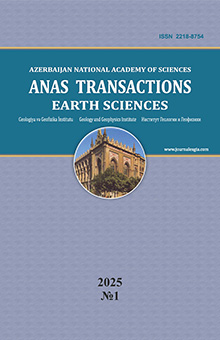№ 2,
2020
Download the article
Structural hierarchy of Ca- and TR- triorthosilicates and their derivatives
Crystallography, mineralogy and geochemistry department, Baku State University 23, Acad. Zakhid Khalilov str., Baku, Azerbaijan, AZ 1148: afashf@rambler.ru
Summary
A-
A+
It is known that physical and chemical properties and paragenetic peculiarities of minerals are related to their crystalline structure. The hierarchical scheme of mineral structure re-search shows that classification according to chemical composition does not give a complete picture of the minerals’ properties. Taking into account the well-known works of M.I.Chiragov and F.C.Hawthorne on the structural classification of minerals, the structures of Ca- and TR-triortosilicates and their derivatives are considered for the first time in this paper using the comparative crystal chemistry method and structural hierarchy. The structural hierarchy of minerals is based on the primary polymerization of different type coordination polyhedra which results in formation of the parent structural minals or clusters. Taking into account the symmetry of triorto-silicates and the form of polymerisation of tetrahedrons with Ca- and TR-octahedrons, four types of clusters with different configurations and chemical compositions have been identified: |M(Si3O10)(H2O)3|, |M(Si3O10)2|, |M(Si3O10)(H2O)4| and |M(Si3O10)2(H2O)2|. Depending on the shape of clusters polymerization, a hierarchical scheme for the formation of structural types of Ca- and TR-triortosilicates and their derivatives is presented. This results in the formation of structural blocks and mixed frames with calcium atoms in Ca-silicates and sodium or potassium atoms in TR-silicates. According to the chemical composition and shape of silicon-oxygen radical, such minerals as delhayelite and macdonaldite are included in one group. According to the structural classification with the extraction of clusters, it was found out that the structures of these minerals are formed from two different configurations of minals and, consequently, as a result of their polymerization, different structural types are formed. The substantiation of the structural hierarchy is reflected in the conditions of formation of the group of minerals delhayelite and macdonaldite. The formation of dolchayelite is associated with the high-temperature stage of pegmatite formation at the stage of entry of potassium-rich metamorphosing solutions. Hydro-delhayelite is a product of hypergenesis and hydrothermal change of delhayelite. Under these conditions the removal of sodium, partially potassium and all fluorine and chlorine takes place. The structural type of mac-donaldite is associated with low temperature stage of pegmatite formation or with late hydrothermal stage of mineral formation. In all cases, however, the medium must be highly alkaline and calcium-rich for the macdonaldite structural type or rich in rare earth cations for the monterejianite structure. These structural features are tested indicators for mineral formation processes.
Keywords: Ca- and TR- triorthosilicates, clusters, structural units, structural blocks, formation of structures
REFERENCES
Aksenov S.M., Shipalkina N.V., Rastsvetaeva R.K., Rusakov V.S., Pekov I.V., Chukanov N.V., Yapaskurt V.O. Iron-rich bustamite from Broken Hill, Australia: The crystal structure and cation-ordering features. Crystall. Reports, Vol. 60, 2015, pp. 340-345.
Camara F., Ottolini L., Devouard B., Garvie L.A.J., Hawthorne F.C. Sazhinite-(La), Na3LaSi6O15(H2O)2, a new mineral from the Aris phonolite, Namibia: Description and crystal structure. Mineral. Mag., Vol. 70, No. 4, 2006, pp. 405-418.
Cannillo E., Rossi G., Ungaretti Z. The crystal structure of macdonaldite. Atti Accad. Naz. Lincei, Rend Classe Sci. Fis. Mat. Nat., serie VIII, Vol. 45, 1968, pp. 399-414.
Chiragov M.I., Ragimov K.G., Mamedov Kh.S. Crystal structure of the synthetic triorthosilicate K3H2HoSi3O10. Uchenye Zapiski ASU. Ser. geol. Sciences, 1979, No. 4, pp. 8-15 (in Russian) .
Chiragov M.I., Ragimov K.G., Mamedov Kh.S., Dorfman M.D. The crystal structure of hydrodelhayelite, KH2Ca2(Si,Al)8O19 · 6H2O, Dokl. Akad. nauk Az,SSR, Vol. 36, No. 12, 1980, pp. 49-51 (in Russian).
Chiragov M.I., Dorfman M.D. Crystal-chemistry of the minerals of the delhayelite group. Dok. Akad. Nauk SSSR, Vol. 260, 1981, pp. 458-461 (in Russian).
Chiragov M.I., Ragimov K.G. Crystal-chemical features of the thermal conversion of K3HoSi3O8(OH)2. Materials of the All-Union conference on the crystal chemistry of inorganic and coordination compounds. Publishing of AS of the USSR. Bukhara, 1986, p. 129 (in Russian).
Chiragov M.I., Pushcharovsky D.Y. Polysomatism and structural models of Ca-silicates. Kristallografiya, Vol. 36, No. 5, 1991, p. 1200-1206 (in Russian).
Chiragov M.I. Comparative crystal chemistry of calcium and rare earth silicates. Chashyogly. Baku, 2002, 360 p. (in Russian).
Ghose S., Gupta P.K.S., Campana C.F. Symmetry and crystal structure of monteregianite, Na4K2Y2Si16O38·10H2О, a double-sheet silicate with zeolitic properties. Amer. Mineral., Vol. 72, 1987, pp. 365-374.
Hawthorne F.C. Graphical enumeration of polyhedral clusters. Acta Cryst., Vol. A39, 1983, pp. 724-736.
Hawthorne F.C. Towards a structural classification of minerals: The VIMIVT2On minerals. Amer. Mineral., Vol. 70, 1985, pp. 455-473.
Hawthorne F.C. Structural hierarchy in VIMxIIITyФz minerals. Canad. Mineral., Vol. 24, 1986, pp. 625-642.
Hejny C., Armbruster T. Polytypism in xonotlite Ca6Si6O17(OH)2. Z. Kristallogr., Vol. 216, 2001, pp. 396-408.
Hesse K.F., Liebau F., Merlino S. Crystal structure of rhodesite. Z. Kristallogr., Vol.199, 1992, pp. 25-48.
Ito T., Sadanada R., Takeuchi Y., Tokonami M. The existence of partial mirrors in wollastonite. Proc. Jpn. Acad., Vol. 45, 1969, pp. 913-918.
Ito T., Sadanada R., Takeuchi Y., Tokonami M. The existence of partial mirrors in wollastonite. Proc. Jpn. Acad., Vol. 45, 1969, pp. 913-918.
Shirinova A.F. Comparative crystal chemistry of mixed silicates structures. Baku, 2018, 242 p. (in Russian).
Teymurov G.S., Chiragov M.I., Mamedov Kh.S., Mustafayev N.M. Crystal-chemical features of the conversion of calcium sulfate dihydrate into semi-aqueous gypsum. Inorganic Materials. Izvestiya of Academy of Sciences of the USSR, Vol.15, No.8, 1979, pp.1489-1491.
DOI:
10.33677/ggianas20200200047
